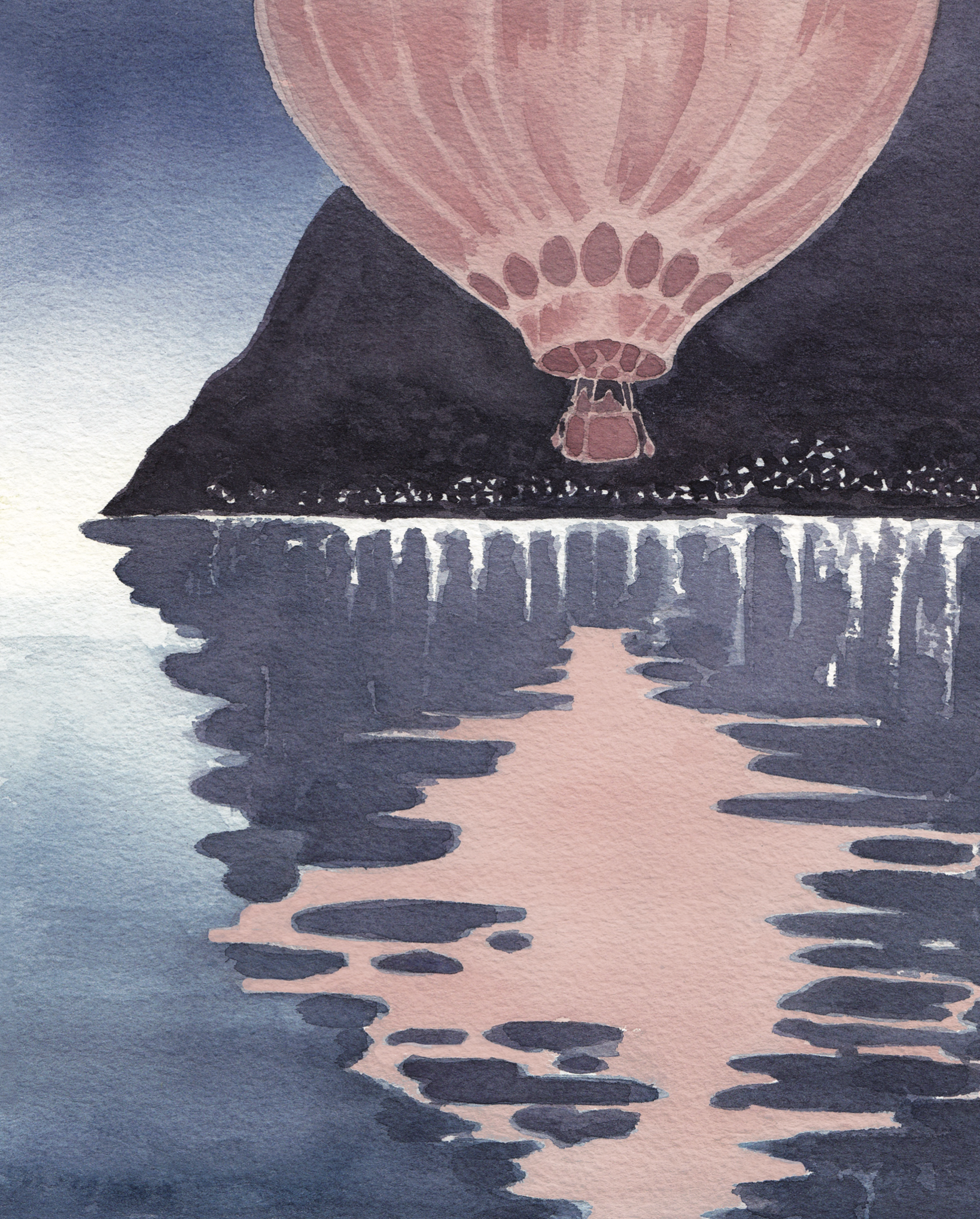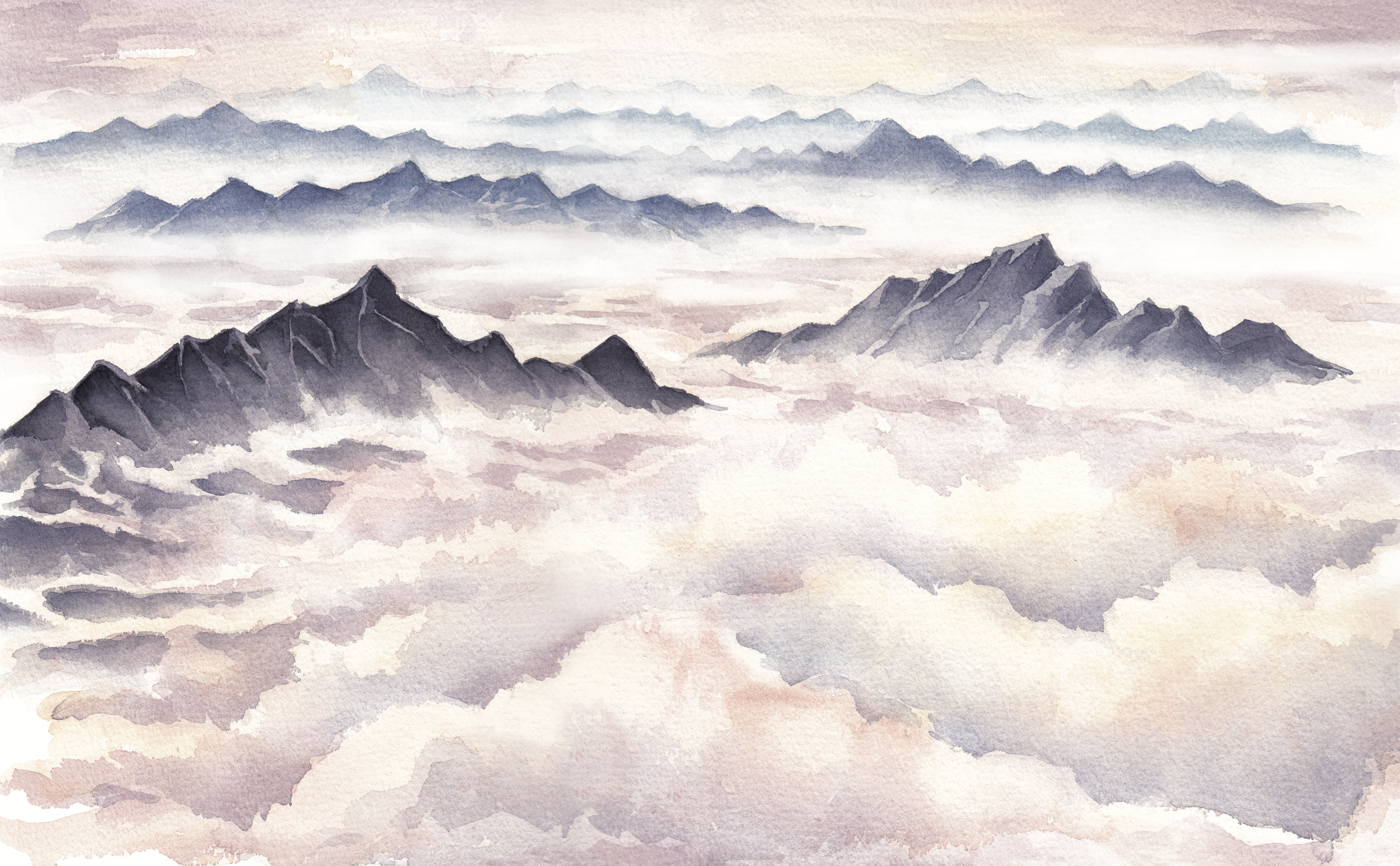Over the Alps by Balloon
Words by Kristen Cosby & Illustrations by Piera Cirefice - and extract from the Switzerland magazine.
We launch the balloon pre-dawn from an obscure airfield in the petite Swiss city of Villeneuve, just beside Lake Geneva. I do not feel the moment we depart Earth. Our rise doesn’t coincide with the burst of flame overhead. Rather, it’s like call and response. The ground retreats... fast... then faster.
There are four of us in the basket. Laurent Sciboz and Yannick Serex, both members of the Swiss ballooning team that shattered the world record for the longest continuous hydrogen balloon flight during the 2017 America’s Challenge Race. The third pilot, Louisa, is Yannick’s former student, a 28 year old competitive balloonist (she’s so good, Yannick told me, that a notable balloon-maker had built a beautiful red gas balloon for her). And me, an American traveller who’d jumped aboard a vessel the size of a bathtub with three strangers because she loves chasing horizons.
Laurent shines his head lamp onto the treetops, cautioning about branches and power lines, but they quickly vanish into the splatter of human luminance. Still just this side of dawn, Earth remains indigo and black, interrupted only by miniature street lamps, the soft sheen atop the lake and the flame from our burner. We climb a little higher and the valley flattens, losing dimensions. Large details become fine and precious. The brightening twilight reveals a perfect oil painting of minute buildings and teeny-tiny cars.
We pause our ascent, hovering relatively low. Traffic begins to rustle the roadways. We’ve been aloft a half hour but the clocks have relinquished their relevance. We remain connected to civilisation by the whir of highway traffic and connected to Earth by the scent of loam and water.
Operating with headlamps switched red so our night vision remains pure, Louisa tends the burners while Yannick unclips his pack from the exterior of the basket and pulls out a red snowsuit into which I’m bundled. I am going to be glad for the down-filled layer when we get above the mountains, Yannick informs me. A beat: “Above the mountains?” When I’d swung my leg over the edge of the basket, I’d imagined this would be a short tourist trip.
Yannick studies the terrain below and sends a wad of spit over the rail. “Did you see someone you don’t like?” I ask. Laurent lifts his face from his camera; “No, he’s measuring the direction of the wind to see if we can kiss the lake.”
“Just a little kiss,” Yannick smooches the air. “Un bec from the bottom of the basket.” In winter, he’s been known to skate the bottom of the basket along the frozen surface. Sometimes, he brings the basket down hard and fast to see if he can crack the ice before lifting off again.
Spitting reveals that the wind will not take us over the water. Not if we want to travel today. The material of the balloon-envelope is so thin that the hot air is constantly escaping - it requires periodic burns of our six large bottles of liquid propane just to hover. To rise, Yannick increases the frequency of the burns. Our headway is entirely dependent upon the various winds at different elevations and Yannick’s knowledge of these invisible currents and eddies. He points to a saddle between the foothills. We will catch the river of wind that blows off the lake and crests the ridge by funnelling through the saddle. And then? “We go where the wind decides,” Laurent tells me. If the sky is willing, we might drift for six or seven hours.
The foothills approach and loom. Just when I start to smell the close and wet hillsides, the balloon finds the wave of air and we are lifted up and over the saddle.
Dawn arrives as we pop over the ridge, returning colour to the world. I suck in my breath. In the new light, mountains crowd like glittering sharks’ teeth, a sea of white-capped peaks. The real game revealed. We are at an elevation of 726 metres and climbing. “On montre,” Yannick booms. “Time is not a friend of the gas balloon.”
Once over the ridge, we descend into the Simmen Valley. A channel of cold air funnels between the mountains, carrying us northeast over the fields and forests at approximately five miles per hour. Later our navigational devices reveal that we’d topped out at a speed of 30mph, but I don’t notice the acceleration. Impervious to the currents that pull us along, we hang alongside peaks covered in Lilliputian trees, over a green patchworked valley sparsely threaded with pale roads and spotted with chalets and farmhouses and brown dots that are likely cows.
Even in a storm, the snow feathers against your skin, Yannick tells me, because the balloon travels as part of the weather. Only when you land do you feel the rip of the wind, the gouge of sleet. “The problems are there,” he points downwards, “you are here.” This high, you sense the concept of life but without individual actors or movement. Chaos and trouble flatten into a map that reveals all its secrets and ways. You cannot be lost, and that’s a great comfort.
Lower, the air warms. We pass over La Valsainte, close enough to the ground that the trees have become individual again, as have the tiles on the red-peaked roofs that make up the oldest monastery in Switzerland; built in 1295, almost 500 years before humankind’s first foray into the air via balloon. I imagine the monks of La Valsainte enacting their isolated routines. Perhaps in summer they found pleasure in hiking up the steep, lush hillsides to meditate on divine omnipotence or, simply, what it would be like to alight towards the heavens.
“On montre!” To the Alps! Towards the sun! Where the air is so bereft of oxygen that our brains would turn to mush, unable to cognate or form memory. Louisa takes over the gas while Yannick assembles the oxygen tubes, singing: “Pour la mémoire!” I echo, “For memory!” We’ve gotten a bit goofy with the excellence of the conditions. A flight like this doesn’t happen every day.
Laurent handles air traffic control, who demand to know our destination. “Towards Thun,” repeats Laurent, though for all we know we’ll end up in France. L’autobahn du vent, the highway of wind, sweeps unimpeded across the upper deck of the sky, beckoning us. And we rise to meet it.
When my oxygen tube slips from my nose, Louisa is quick to replace it, saying: “If it falls out, you will not notice when you stop thinking and remembering.” Yannick tells me to extend my middle finger so he can measure my blood-oxygen level to be sure I’m breathing correctly. 99.9 percent, normal. Later, I’ll see video footage of Yannick and Laurent’s first flight together, a three hour escapade over the Italian Alps. Once aloft their oxygen tubes proved defective. Laurent’s blood-oxygen level dropped to 65 percent. On the film Yannick asks Laurent, “what’s two plus two?” Pale and haggard, Laurent’s movements and speech slow and thicken. He cannot calculate the sum. Yannick writes notes in gibberish that he is unable to decipher once they’d managed to land.
Terra firma has fallen further away and once again we can see far afield: neighbouring cities and towns and lakes and the mountain range beyond the valley. “Oh, it’s raining over Freibourg, isn’t that funny,” says Louisa. I look up from my oxygen dial just in time to watch the world disappear. We’ve punctured the swath of stratonimbus that is bringing rain to the city across the lake. Being rendered invisible within the flight deck beckons my worst fears. We are borderline socked-in but, Yannick predicts, not for long. We will monitor the communication channel and wait.
There is nothing to be curious about except when we will exit the clouds. I curl and uncurl my toes for luck. My feet are cold, the temperature having dropped to -10°C. My red suit protects all of me but my extremities. My face is kept warm by the flame.
Between the exhale of dragon fire, the puff-hiss of my oxygen tube and the occasional beep that confirms that I breathe, no sound lingers but the slight creak of the basket swinging from the stays and the squeak of straw and plywood when someone moves and the basket floor shivers. A dense, eerie calm closes in. It should be touchable but when I reach my hand into the grey mass there’s nothing, just a hand against the void. The world, the sun, gone. “Now we go to paradise,” says Louisa.
All at once, the grey walls dissolve. We break through the clouds at 2,570 metres, above the peaks; the dazzle of Alpine snowcaps and the white, innocuous clouds below stab the eyes. But we can see forever, into tomorrow and yesterday. Yannick pulls the gas lever and we leave the clouds below.
At our apex, 4,480 metres, we become astronauts in orbit. Earth is so distant and still that it’s alien, a static concept. If magic is the ability to change one’s perspective, then this is sorcery. You have to reconsider your place in space and time, you have to give yourself over to the largeness of the sky, and you have to believe that something will continue to cradle you aloft - the laws of physics, the expertise of your pilot, the gods of wind and sky. Ballooning, above all other sports or modes of travel I’ve attempted, is a state of being. It’s been hours since I ate or drank or had proper rest, but I’m not thirsty or hungry. I want for nothing. It’s as if I’d paused the world and stepped away for a moment of quiet observation at creation and decided that it was blessedly enough.
We descend over a field near Kaufdorf. Not exactly where we’d reported landing but close. There are no safety belts. As we approach, our shadow looms and rushes swiftly to meet us. We bump hard and the basket begins to tip onto its side. Yannick pulls the red line that collapses the parachute atop the balloon, spilling the last of our air, and the basket thumps solidly upright. Children flock from the village on bicycles pointing and shouting. Le ballon sighs and puddles in the grass. And we become mortals again.




